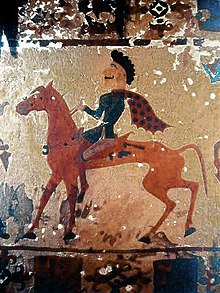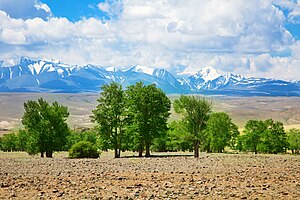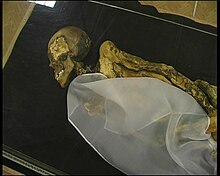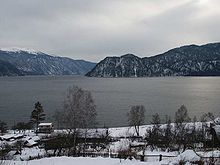
Horseman, Pazyryk felt artifact, c.300 BC. For another felt artifact, see here.
The tombs are Scythian-type kurgans, barrow-like tomb mounds containing wooden chambers covered over by large cairns of boulders and stones, dated to the 4th – 3rd centuries BCE.[5] The spectacular burials at Pazyryk are responsible for the introduction of the term kurgan, a Russian word of Turkic origin, into general usage to describe these tombs. The region of the Pazyryk kurgans is considered the type site of the wider Pazyryk culture. The site is included in the Golden Mountains of Altai UNESCO World Heritage Site.[6]
The bearers of the Pazyryk culture were horse-riding pastoral nomads of the steppe, and some may have accumulated great wealth through horse trading with merchants in Persia, India and China.[7] This wealth is evident in the wide array of finds from the Pazyryk tombs, which include many rare examples of organic objects such as felt hangings, Chinese silk, the earliest known pile carpet, horses decked out in elaborate trappings, and wooden furniture and other household goods. These finds were preserved when water seeped into the tombs in antiquity and froze, encasing the burial goods in ice, which remained frozen in the permafrost until the time of their excavation.
“At Pazyryk too are found bearded mascarons (masks) of well-defined Greco-Roman origin, which were doubtless inspired by the Hellenistic kingdoms of the Cimmerian Bosporus.”[8]
The first tomb at Pazyryk, barrow 1, was excavated by the archaeologist M. P. Gryaznov in 1929; barrows 2-5 were excavated by Sergei Ivanovich Rudenko in 1947-1949.[9] While many of the tombs had already been looted in earlier times, the excavators unearthed buried horses, and with them immaculately preserved cloth saddles, felt and woven rugs including the world’s oldest pile carpet,[10][11] a 3-metre-high four-wheel funeral chariot from the 5th century BC and other splendid objects that had escaped the ravages of time.[12] These finds are now exhibited at the Hermitage Museum in St. Petersburg.
Craniological studies of samples from the Pazyryk burials determined that skulls were generally of Europoid type, with some showing Mongoloidfeatures.[13]
Pazyryk chief
Rudenko’s most striking discovery was the body of a tattooed Pazyryk chief: a thick-set, powerfully built man who had died when he was about 50. Parts of the body had deteriorated, but much of the tattooing was still clearly visible (see image). Subsequent investigation using reflected infrared photography revealed that all five bodies discovered in the Pazyryk kurgans were tattooed.[14] No instruments specifically designed for tattooing were found, but the Pazyryks had extremely fine needles with which they did miniature embroidery, and these were probably used for tattooing.
The chief was elaborately decorated with an interlocking series of striking designs representing a variety of fantastic beasts. The best preserved tattoos were images of a donkey, a mountain ram, two highly stylized deer with long antlers and an imaginary carnivore on the right arm. Two monsters resembling griffins decorate the chest, and on the left arm are three partially obliterated images which seem to represent two deer and a mountain goat. On the front of the right leg a fish extends from the foot to the knee. A monster crawls over the right foot, and on the inside of the shin is a series of four running rams which touch each other to form a single design. The left leg also bears tattoos, but these designs could not be clearly distinguished. In addition, the chief’s back is tattooed with a series of small circles in line with the vertebral column. This tattooing was probably done for therapeutic reasons. Contemporary Siberian tribesmen still practice tattooing of this kind to relieve back pain.
Ice Maiden
Two years after the discovery of the “Ice Maiden” Dr. Polosmak’s husband, Vyacheslav Molodin, found a frozen man, elaborately tattooed with an elk, with two long braids that reached to his waist, buried with his weapons.
Doctor Anicua also noted that her blouse was a bit stained, indicating that that the material was not a new garment, made for the burial.
Pazyryk carpet
Other findings
In a corner of one grave chamber of the Pazyryk cemetery was a fur bag containing cannabis seed, a censer filled with stones, and the hexapod frame of an inhalation tent – these are believed to have been utilized at the end of the funerary ritual for purification.
Other undisturbed kurgans have been found to contain remarkably well-preserved remains, comparable to the earlier Tarim mummies of Xinjiang. Bodies were preserved using mummification techniques and were also naturally frozen in solid ice from water seeping into the tombs. They were encased in coffins made from hollowed trunks of larch (which may have had sacral significance) and sometimes accompanied by sacrificed concubines and horses. The clustering of tombs in a single area implies that it had particular ritual significance for these people, who were likely to have been willing to transport their deceased leaders great distances for burial.
As recently as the summer of 2012, tombs have been discovered at various locations.[citation needed] In January 2007 a timber tomb of a blond chieftain warrior was unearthed in the permafrost of the Altai mountains region close to the Mongolian border.[18] The body of the presumed Pazyryk chieftain is tattooed; his sable coat is well preserved, as are some other objects, including what looks like scissors. A local archaeologist, Aleksei Tishkin, complained that the indigenous population of the region strongly disapproves of archaeological digs, prompting the scientists to move their activities across the border to Mongolia.[19]
Pazyryk culture
It has been suggested{who} that Pazyryk was a homeland for these tribes before they migrated west[citation needed]. There is also the possibility that the current inhabitants of the Altairegion are descendants of the Pazyryk culture, a continuity that would accord with current ethnic politics: Archaeogenetics is now being used to study the Pazyryk mummies.
Citations
- “Pazyryk”. Encyclopædia Britannica Online. Encyclopædia Britannica. Retrieved March 2, 2015.
- “Scythian Art”. Encyclopædia Britannica Online. Encyclopædia Britannica. Retrieved March 2, 2015.
- “Drug cult: History of drug use in religion”. Encyclopædia Britannica Online. Encyclopædia Britannica. Retrieved March 2, 2015.
- a b c d “Ice Mummies: Siberian Ice Maiden”. PBS – NOVA. Retrieved 2009-09-01.
- A Special Issue on the Dating of Pazyryk. Source: Notes in the History of Art 10, no. 4, p. 4.
- “Golden Mountains of Altai”. UNESCO. Retrieved 2007-07-31.
- a b Bahn, Paul G. (2000). The Atlas of World Geology. New York: Checkmark Books. p. 128. ISBN 0-8160-4051-6.
- Grousset, Rene (1970). The Empire of the Steppes. Rutgers University Press. pp. 18–19. ISBN 0-8135-1304-9.
- Rudenko 1970, p. 18, 33
- “Rug and carpet: Oriental carpets”. Encyclopædia Britannica Online. Encyclopædia Britannica. Retrieved March 2, 2015.
- “Central Asian Arts: Altaic tribes”. Encyclopædia Britannica Online. Encyclopædia Britannica. Retrieved March 2, 2015.
- “Stone Age: European cultures”. Encyclopædia Britannica Online. Encyclopædia Britannica. Retrieved March 2, 2015.
- Rudenko 1970, p. 45 “Although in general the skulls in the series are of europeoid type, there are some among them with markedly mongoloid features.”
- Findings published in Archaeology, Ethnology and Anthropology of Eurasia, Spring 2005.
- Polosmak, Natalia (1994). “A Mummy Unearthed from the Pastures of Heaven.” National Geographic 186:4, p. 91.
- Polosmak (1994), pp. 98-99.
- “History of handknotted carpets”. CarpetEncyclopedia.com. Retrieved March 2, 2015.
- “Russian Archaeologists Discover Remains of Ancient Chieftain in Altai Permafrost”. 2007-01-10. Retrieved 2007-05-06.
- Daria Radovskaya (2007-01-10). “Кочевник был блондином”. Rossiyskaya Gazeta. Retrieved 2007-05-06.
- See above, n. 2.
- “Early Nomads of the Altaic Region”. The Hermitage. Retrieved 2007-07-31.
Sources
- Rudenko, Sergei Ivanovich (1970). Frozen Tombs of Siberia: The Pazyryk Burials of Iron Age Horsemen. University of California Press. ISBN 0520013956. Retrieved March 1, 2015.
External links
- (Russian) A library of scholarly publications about the Altai Scythians
- A collection at Novosibirsk State University site, including Pazyryk
- Pazyryk carpet, at State Hermitage Museum
- BME wiki: Pazyryk Mummies
- (Discovery Channel) Winnie Allingham, “The frozen horseman of Siberia”
- “Ancient Mummy found in Mongolia”, Der Spiegel, 2004
- “Ice Maiden recreated in photographic project”, Sydney Australia, 2009
- ‘The Preservation of the Frozen Tombs of the Altai Mountains’, UNESCO (pdf)
- http://www.mnh.si.edu/arctic/html/pdf/Rock%20Art%20and%20Archaeology%20Field%20Report%202011%20FINAL_webv4.pdf
Golden Mountains of Altai
| Golden Mountains of Altai | |
|---|---|
 |
|
| Type | Natural |
| Criteria | x |
| Reference | 768 |
| UNESCO region | Europe |
| Inscription history | |
| Inscription | 1998 (22nd Session) |
Golden Mountains of Altai is the name of an UNESCO World Heritage Site consisting of the Altai and Katun Natural Reserves, Lake Teletskoye, Belukha Mountain, and the Ukok Plateau. As stated in the UNESCO description of the site, “the region represents the most complete sequence of altitudinal vegetation zones in central Siberia, from steppe, forest-steppe, mixed forest, subalpine vegetation to alpine vegetation”.[1] While making its decision, UNESCO also cited Russian Altai’s importance for preservation of the globally endangered mammals, such as snow leopard and the Altai argali. The site covers a vast area of 16,175 km².[2]
Notes
- “Golden Mountains of Altai”. UNESCO. Retrieved 2007-07-31.
- “Greater Altai – Altai Krai, Republic of Altai, Tyva (Tuva), and Novosibirsk – Crossroads”. Retrieved 2006-11-30.
External links
- Location map
- Altai Republic Recreation Areas
- Golden Mountains, Altai Republic, Russia
- Golden Mountains of Altai at Natural Heritage Protection Fund
A striking originality is characteristic of the nature of this mountain Altai territory situated on the border of the Central Asia and the Siberia. In the basin of the Teletskoye Lake Altai cedar forests still remain. Here we also can find very large for Siberian mountains alpine and subalpine grasslands. The vegetation of the Southern Altai where semi-deserts, steppes and tundra easily coexist is also amazing.
Different landscape types facilitated creation and conservation of Altai endemic organisms. This area is the home of 60 mammal species, including ounce or snow leopard, 11 amphibia and reptile species and 20 fish species.
Terrain forms are very unusual here. Mount Belukha, the Siberia’s highest mountain (4,506 m above the sea level), is very impressive in its grandeur. The Teletskoye Lake is the true pearl of the Altai. People call the lake a second Baikal because of its clearest waters, beautiful mountains surrounding it and the richest wildlife of the lake.
News
Documents
- Информационно-аналитические материалы по реализации Российской Федерацией Конвенции об охране всемирного культурного и природного наследия (ЮНЕСКО) в природной ее части
- Роль Конвенции об охране всемирного наследия в сохранении биологического и ландшафтного разнообразия России
- World Natural Heritage Territories in Russia and Ecological Tourism (RSS Final Report)
- Development strategy and Management of the World Natural Heritage Property Golden Mountains of Altai
- Golden Mountains of Altai (Russian Federation) (N 768rev) – Decisions adopted at the 37th session (Phnom Penh, 16-27 of June, 2013)
- Golden Mountains of Altai (Russian Federation (N 768rev) – Decisions adopted at the 36th Session (St.-Petersburg, 2012)
- State of conservation of World Heritage Property Golden Mountains of Altai (N 768 rev) – Decisions adopted at the 33rd Session (Seville, 22-30 June 2009)
- State of conservation of World Heritage Property Golden Mountains of Altai (N 768 rev) – Decisions adopted at the 32nd Session (Quebec City, 2008)
- Booklet “Golden Mountains of Altai – the World Heritage Property”
- Resolution of the international workshop “Golden Mountains of Altai – Our Common Heritage”
- International Workshop “Sustainable development of transboundary areas within the Altai region”
- Резолюция международной рабочей встречи “Перспективы расширения объекта Всемирного природного наследия ЮНЕСКО “Золотые горы Алтая”
- Resolution of workshop “Golden Mountains of Altai, UNESCO World Heritage site: results of the work and future prospects”





[…] Herodotus’s account, in Russia’s Altay mountain region near the Siberian and Mongolian border. Close to the bodies was a fur-lined leather bag with cannabis seeds, a bronze cauldron filled with stones and the frame of what seems to be an inhalation […]
LikeLike
[…] Herodotus’s account, in Russia’s Altay mountain region near the Siberian and Mongolian border. Close to the bodies was a fur-lined leather bag with cannabis seeds, a bronze cauldron filled with stones and the frame of what seems to be an inhalation […]
LikeLike
[…] Herodotus’s account, in Russia’s Altay mountain region near the Siberian and Mongolian border. Close to the bodies was a fur-lined leather bag with cannabis seeds, a bronze cauldron filled with stones and the frame of what seems to be an inhalation […]
LikeLike
[…] tài khoản Herodotus, ở khu vực núi Nga Altay gần biên giới Siberia và Mông Cổ. Gần các thi thể là một chiếc túi da lót lông có hạt cần sa, một cái vạc bằng đồng chứa đầy đá và khung của cái dường như là một […]
LikeLike
[…] Herodotus’s account, in Russia’s Altay mountain region near the Siberian and Mongolian border. Close to the bodies was a fur-lined leather bag with cannabis seeds, a bronze cauldron filled with stones and the frame of what seems to be an inhalation […]
LikeLike
[…] Herodotus’s account, in Russia’s Altay mountain region near the Siberian and Mongolian border. Close to the bodies was a fur-lined leather bag with cannabis seeds, a bronze cauldron filled with stones and the frame of what seems to be an inhalation […]
LikeLike
[…] Herodotus’s account, in Russia’s Altay mountain region near the Siberian and Mongolian border. Close to the bodies was a fur-lined leather bag with cannabis seeds, a bronze cauldron filled with stones and the frame of what seems to be an inhalation […]
LikeLike
[…] Herodotus’s account, in Russia’s Altay mountain region near the Siberian and Mongolian border. Close to the bodies was a fur-lined leather bag with cannabis seeds, a bronze cauldron filled with stones and the frame of what seems to be an inhalation […]
LikeLike
[…] Herodotus’s account, in Russia’s Altay mountain region near the Siberian and Mongolian border. Close to the bodies was a fur-lined leather bag with cannabis seeds, a bronze cauldron filled with stones and the frame of what seems to be an inhalation […]
LikeLike
[…] Herodotus’s account, in Russia’s Altay mountain region near the Siberian and Mongolian border. Close to the bodies was a fur-lined leather bag with cannabis seeds, a bronze cauldron filled with stones and the frame of what seems to be an inhalation […]
LikeLike
[…] Herodotus’s account, in Russia’s Altay mountain region near the Siberian and Mongolian border. Close to the bodies was a fur-lined leather bag with cannabis seeds, a bronze cauldron filled with stones and the frame of what seems to be an inhalation […]
LikeLike
[…] Herodotus’s account, in Russia’s Altay mountain region near the Siberian and Mongolian border. Close to the bodies was a fur-lined leather bag with cannabis seeds, a bronze cauldron filled with stones and the frame of what seems to be an inhalation […]
LikeLike
[…] Herodotus’s account, in Russia’s Altay mountain region near the Siberian and Mongolian border. Close to the bodies was a fur-lined leather bag with cannabis seeds, a bronze cauldron filled with stones and the frame of what seems to be an inhalation […]
LikeLike
[…] Herodotus’s account, in Russia’s Altay mountain region near the Siberian and Mongolian border. Close to the bodies was a fur-lined leather bag with cannabis seeds, a bronze cauldron filled with stones and the frame of what seems to be an inhalation […]
LikeLike
[…] Herodotus’s account, in Russia’s Altay mountain region near the Siberian and Mongolian border. Close to the bodies was a fur-lined leather bag with cannabis seeds, a bronze cauldron filled with stones and the frame of what seems to be an inhalation […]
LikeLike
[…] Herodotus’s account, in Russia’s Altay mountain region near the Siberian and Mongolian border. Close to the bodies was a fur-lined leather bag with cannabis seeds, a bronze cauldron filled with stones and the frame of what seems to be an inhalation […]
LikeLike
[…] Herodotus’s account, in Russia’s Altay mountain region near the Siberian and Mongolian border. Close to the bodies was a fur-lined leather bag with cannabis seeds, a bronze cauldron filled with stones and the frame of what seems to be an inhalation […]
LikeLike
[…] Herodotus’s account, in Russia’s Altay mountain region near the Siberian and Mongolian border. Close to the bodies was a fur-lined leather bag with cannabis seeds, a bronze cauldron filled with stones and the frame of what seems to be an inhalation […]
LikeLike
[…] to inhale the smoke captured in the tent “hot box” style. Archeologists in the last century, recovered such implements and the carbonized remains of burnt cannabis, at a number of Scythian sites, confirming Herodotus […]
LikeLike
[…] the smoke captured in the tent “hot box” style. Archeologists in the last century, recovered such implements and the carbonized remains of burnt cannabis, at a number of Scythian sites, confirming Herodotus […]
LikeLike
[…] to inhale the smoke captured in the tent “hot box” style. Archeologists in the last century, recovered such implements and the carbonized remains of burnt cannabis, at a number of Scythian sites, confirming Herodotus […]
LikeLike
[…] to inhale the smoke captured in the tent “hot box” style. Archeologists in the last century, recovered such implements and the carbonized remains of burnt cannabis, at a number of Scythian sites, confirming Herodotus […]
LikeLike
[…] to inhale the smoke captured in the tent “hot box” style. Archeologists in the last century, recovered such implements and the carbonized remains of burnt cannabis, at a number of Scythian sites, confirming Herodotus […]
LikeLike
[…] to inhale the smoke captured in the tent “hot box” style. Archeologists in the last century, recovered such implements and the carbonized remains of burnt cannabis, at a number of Scythian sites, confirming Herodotus […]
LikeLike
[…] the smoke captured in the tent “hot box” style. Archeologists in the last century, recovered such implements and the carbonized remains of burnt cannabis, at a number of Scythian sites, confirming Herodotus […]
LikeLike
[…] to inhale the smoke captured in the tent “hot box” style. Archeologists in the last century, recovered such implements and the carbonized remains of burnt cannabis, at a number of Scythian sites, confirming Herodotus […]
LikeLike
[…] to inhale the smoke captured in the tent “hot box” style. Archeologists in the last century, recovered such implements and the carbonized remains of burnt cannabis, at a number of Scythian sites, confirming Herodotus […]
LikeLike
[…] smoke captured within the tent “scorching field” type. Archeologists within the final century, recovered such implements and the carbonized stays of burnt hashish, at quite a lot of Scythian websites, confirming Herodotus […]
LikeLike
[…] to inhale the smoke captured in the tent “hot box” style. Archeologists in the last century, recovered such implements and the carbonized remains of burnt cannabis, at a number of Scythian sites, confirming Herodotus […]
LikeLike
[…] to inhale the smoke captured in the tent “hot box” style. Archeologists in the last century, recovered such implements and the carbonized remains of burnt cannabis, at a number of Scythian sites, confirming Herodotus […]
LikeLike
[…] to inhale the smoke captured in the tent “hot box” style. Archeologists in the last century, recovered such implements and the carbonized remains of burnt cannabis, at a number of Scythian sites, confirming Herodotus […]
LikeLike
[…] to inhale the smoke captured in the tent “hot box” style. Archeologists in the last century, recovered such implements and the carbonized remains of burnt cannabis, at a number of Scythian sites, confirming Herodotus […]
LikeLike
[…] to inhale the smoke captured in the tent “hot box” style. Archeologists in the last century, recovered such implements and the carbonized remains of burnt cannabis, at a number of Scythian sites, confirming Herodotus […]
LikeLike
[…] account, in Russia’s Altay mountain area close to the Siberian and Mongolian border. Close to the bodies was a fur-lined leather bag with cannabis seeds, a bronze cauldron crammed with stones and the body of what appears to be an inhalation […]
LikeLike
[…] account, in Russia’s Altay mountain area close to the Siberian and Mongolian border. Close to the bodies was a fur-lined leather bag with cannabis seeds, a bronze cauldron full of stones and the body of what appears to be an inhalation […]
LikeLike